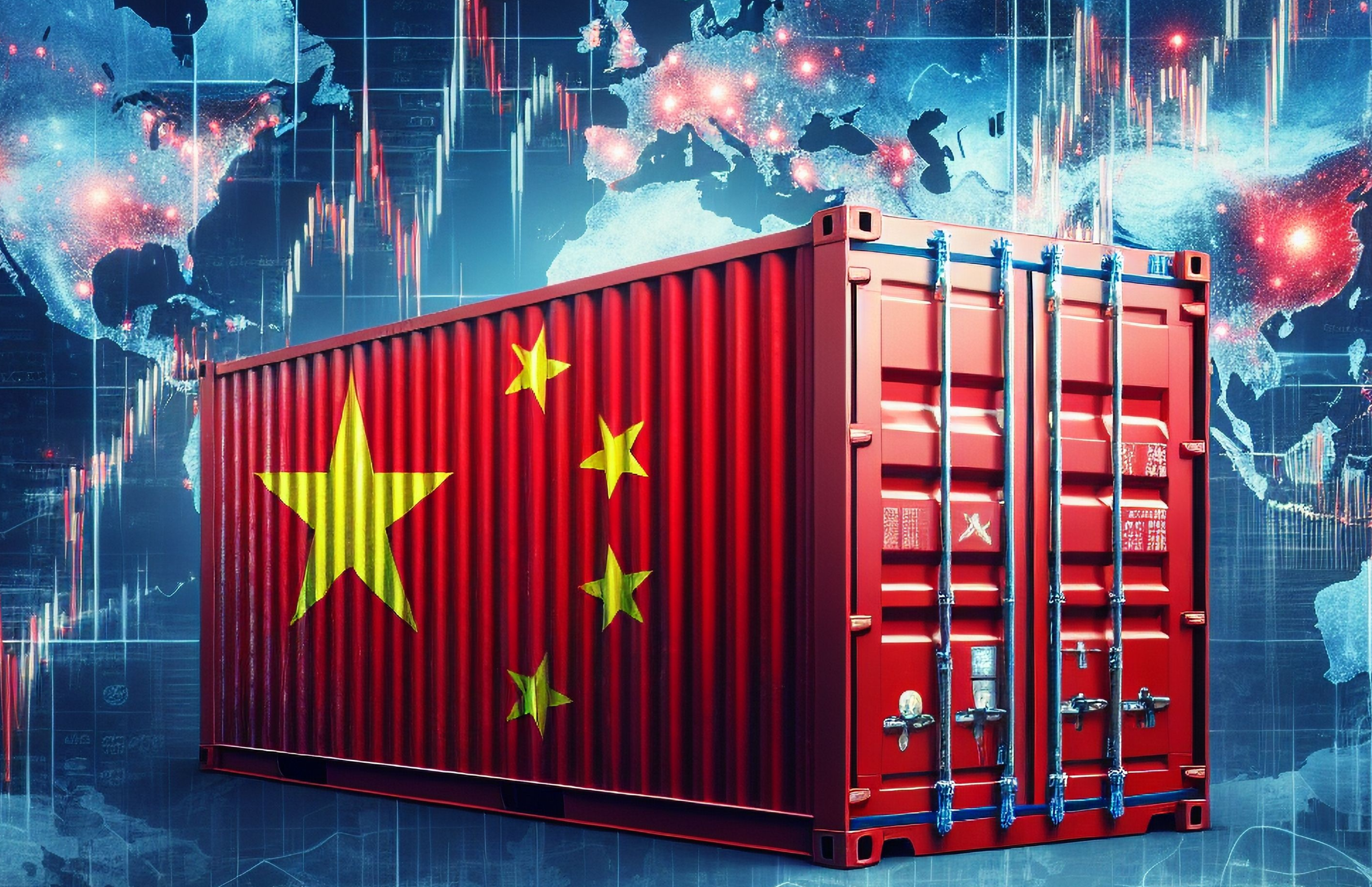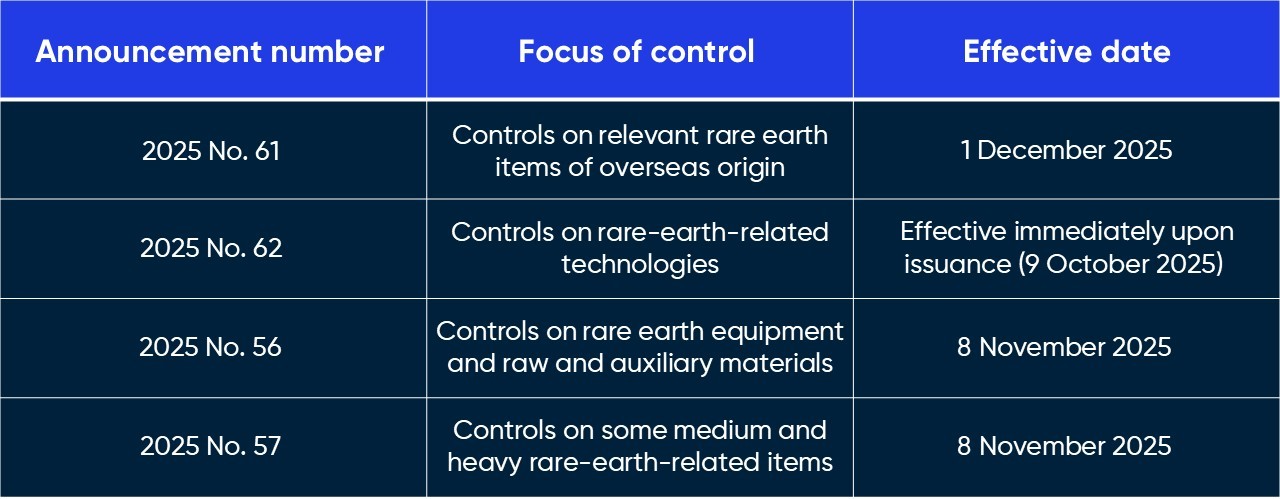China's Ministry of Commerce announces enhanced export controls on rare earths
Opinion Pieces

10
Oct
2025
China's Ministry of Commerce announces enhanced export controls on rare earths
On 9 October, immediately following China's National Day holiday, the Ministry of Commerce, in conjunction with the General Administration of Customs, issued four announcements concerning export controls on rare earth materials and technologies. These measures represent a significant enhancement of China's export control framework for rare earths.
The key details of these announcements are summarised in the table below:

China's Ministry of Commerce has issued four announcements establishing comprehensive export controls covering technologies and their carriers across the entire rare earth supply chain—from mining and smelting to magnetic material manufacturing and secondary resource recycling. These measures extend to equipment, raw materials, and medium and heavy rare earths; crucially, they impose controls on rare earth items and technologies involving foreign entities.
Announcement No. 61 significantly expands the control scope to include foreign organisations and individuals. It mandates that any foreign exporter intending to ship rare-earth-related materials or technologies to destinations beyond China must first obtain a dual-use item licence from China's Ministry of Commerce, effectively preventing circumvention through transshipment via territories such as Taiwan or regions including Southeast Asia and Central-Southern Africa.
Furthermore, the announcement extends control to all rare earth elements except lanthanum, cerium, praseodymium, and neodymium. It stipulates that any materials—whether containing, integrating, or blending specified rare earth metals and alloys or foreign-manufactured permanent magnets and targets incorporating such Chinese-origin materials valued at 0.1% or more of the end product—fall under the export control framework of China's Export Control Law and Dual-Use Items Export Control Regulations.
The announcement explicitly prohibits export applications destined for foreign military users, entities on official control lists, and their affiliated subsidiaries. It also specifically scrutinises exports intended for developing sub-14nm logic chips, 256-layer or above storage chips, related semiconductor manufacturing equipment, or artificial intelligence with potential military applications. Consequently, any export requests deemed for military end-use are highly unlikely to be approved.
Announcement No. 62 specifies that the definitions of "rare earths," "smelting and separation," "metal smelting," and "secondary rare earth" shall align with China's Rare Earth Administration Regulations. The term "magnetic material manufacturing" encompasses Sm-Co, NdFeB, and Ce magnet production technologies. Controlled items extend to the complete rare earth industrial chain, including production line installation, commissioning, maintenance, and upgrading, together with technical documentation such as design drawings, process specifications, parameters, and simulation data.
The announcement broadly defines “exports” as any transfer of controlled items beyond China's borders or provision to foreign entities regardless of location. This includes not only conventional trade but also transfers via intellectual property licensing, investment, technical exchanges, gifts, training, joint research, or consultancy services. Chinese citizens and organisations are prohibited from providing substantive assistance in overseas rare earth mining, smelting, magnetic material production, or recycling activities.
Supplementary Announcements No. 56 and 57 provide further clarification on controlled items. No. 56 details regulated production equipment, complete processing lines for magnetic materials (including grain boundary diffusion systems) and raw materials such as flotation and extraction reagents. No. 57 specifies controlled forms of medium and heavy rare earths, including alloys, mixtures, oxides, and targets in various physical forms, ranging from ingots and sheets to powders and magnetic materials.
The four announcements effectively bring all rare earth elements except lanthanum, cerium, praseodymium, and neodymium under export control, whilst imposing comprehensive restrictions on related production technologies, equipment, and components.
These new measures, combined with China's existing rare earth management regulations, impact all stages of the rare earth supply chain, spanning from raw and recycled materials to finished magnetic products and specialised equipment. With a one-month window before implementation, both domestic and international end-users are anticipated to accelerate procurement activities. This surge in overseas demand will likely sustain short-term price increases for rare earth materials. However, once export controls take full effect in November, reduced overseas orders may disrupt domestic market equilibrium, creating downward pressure on Chinese rare earth prices in a similar pattern to that observed in the months following the implementation of initial dual-use controls in April 2025. International prices for rare earth elements and products covered by the restrictions are expected to exhibit significant premiums to Chinese domestic prices in the lead-up to and following the implementation of new regulation.
The requirement for additional dual-use licences and accompanying letters of compliance from both the exporter and downstream consumers of the restricted products is likely to cause a bottleneck in processing applications at the Chinese Ministry of Commerce, similar to that observed in April–May 2025. This will undoubtedly delay the return of Chinese export volumes of effected rare earth products to pre-restriction levels beyond early 2026.
The wide-reaching measures will impact the existing supply chains for ex-China military/defense and high-technology industries; additionally, they will slow the ability of the ex-China market to develop alternative supply routes via technology, knowledge, and equipment restrictions. The current development of rare-earth processing capacity ex-China has focused on the four key magnet materials (Nd-Pr-Tb-Dy); however, few processors have explored or designed capability to produce heavy rare earths in the short–medium term. Whilst comparatively minor in volume, the impact that a lack of Ho or Er compounds will have on production in the phosphors, specialty steels, or fibre-optics component manufacture industries ex-China will be significant if dual-use licences are not approved or alternative sources are not secured.